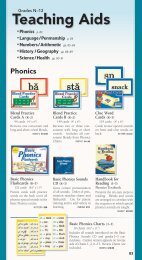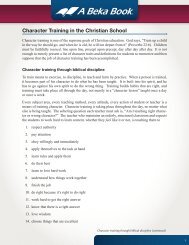Science & Health - A Beka Book
Science & Health - A Beka Book
Science & Health - A Beka Book
You also want an ePaper? Increase the reach of your titles
YUMPU automatically turns print PDFs into web optimized ePapers that Google loves.
Chemistry cont.<br />
Chemistry: An Introduction<br />
h Branches of chemistry, importance of chemistry<br />
• Purpose of science<br />
• Measurement in chemistry:<br />
• F.P.S. and metric system of (SI) units<br />
• Prefixes, measuring length, volume, mass, temperature, and<br />
other quantities<br />
• Scientific notation, precision and accuracy<br />
• Uncertainty, significant figures in measurement and calculation<br />
• Problem solving strategies, unit conversion<br />
• Matter:<br />
• States of matter, melting and boiling point, classification<br />
• John Dalton and atomic theory<br />
h Laws derived from atomic theory<br />
• Energy and matter:<br />
h Quantitative treatment of kinetic energy<br />
• Energy changes in chemical reactions<br />
• First and second laws of thermodynamics<br />
h Introduction to spontaneity<br />
• Endothermic and exothermic<br />
h Careers in chemistry<br />
Matter<br />
• Properties and changes of matter:<br />
h Heterogeneous and homogeneous matter<br />
• Properties of matter<br />
• Physical and chemical changes<br />
h Separation of mixtures<br />
• Elements:<br />
h Relative abundance of elements<br />
• Element symbols and names<br />
• Subatomic particles:<br />
h Discovery of the electron, proton, and neutron<br />
• Other subatomic particles:<br />
• Neutrino<br />
h Positron, meson<br />
• Atomic number, mass number, isotopes, and ions<br />
• Atomic mass:<br />
• Atomic mass units<br />
h Mass spectrometer, mass spectrum<br />
Stoichiometry<br />
• Formulas and names: types of chemical formulas, naming binary<br />
molecular compounds<br />
h Naming ionic compounds: names of ions, determining empirical<br />
formulas<br />
• The mole:<br />
• Molecular masses<br />
h Relative masses and Avogadro’s number, mole, molar mass<br />
• Balancing chemical equations:<br />
• Equations, reactants, products, law of conservation of mass<br />
h Steps for balancing equations<br />
• Classification of chemical reactions:<br />
• Combination (synthesis), decomposition, single displacement<br />
(substitution), and double displacement reactions<br />
h Net ionic equations<br />
<strong>Science</strong><br />
180<br />
Grade 11<br />
h red indicates NeW MATerIAL<br />
h Quantitative relationships from the balanced equation:<br />
h Mole relationships, equivalencies in chemical reactions<br />
h Limiting reactant, mass relationships in chemical reactions<br />
Gases<br />
• Kinetic-molecular theory:<br />
h Five assumptions of kinetic-molecular theory<br />
• Gas pressure:<br />
• Pressure, barometer<br />
h Standard atmosphere, manometers<br />
• The gas laws:<br />
h Ideal gas<br />
• Boyle’s law, Charles’s law, combined gas law<br />
h STP, Gay-Lussac’s law<br />
h Avogadro’s law, molar volume, ideal gas equation<br />
• Diffusion, partial pressures, and stoichiometry:<br />
• Diffusion<br />
h Rates of diffusion, Graham’s law, partial pressure<br />
h Dalton’s law of partial pressures, stoichiometry and gases<br />
h Standard and nonstandard conditions: reactions with gases<br />
Chemical Thermodynamics<br />
• Energy:<br />
• Kinetic and potential energy<br />
h System, surroundings, internal energy<br />
• Heat in chemical reactions:<br />
h Enthalpy<br />
• Endothermic and exothermic reactions<br />
h Calorimetry<br />
h Specific heat, heat of reaction, thermochemical equation<br />
h Standard state, enthalpy of formation, mass-heat calculations<br />
• Heat and changes of state: heat of fusion, heat of vaporization<br />
• Entropy: second law of thermodynamics<br />
Light, Electrons, & Atomic Structure<br />
• Nature of light:<br />
• Property of waves:<br />
• Crest, trough, wavelength, amplitude, frequency, speed<br />
• Classical theories of light, electromagnetic wave, speed of light,<br />
electromagnetic spectrum, quantum theory of light<br />
h Photon, wave-particle duality<br />
• Electrons and the structure of the atom:<br />
• Spectrometer<br />
h Line spectra, continuous spectra, hydrogen spectrum<br />
h Introductory quantitative treatment of Bohr model, details of energy<br />
levels, ground state, excited state, quantized, matter waves<br />
h Schrödinger’s equation<br />
• Uncertainty principle<br />
h Detailed description of electron-cloud model<br />
• Electron configuration and quantum numbers:<br />
h Probability contours, orbital shapes, electron configuration<br />
• Four quantum numbers, Pauli exclusion principle, Hund’s rule<br />
• Valence electrons<br />
h Lewis structures<br />
Chemistry cont. p. 181

















